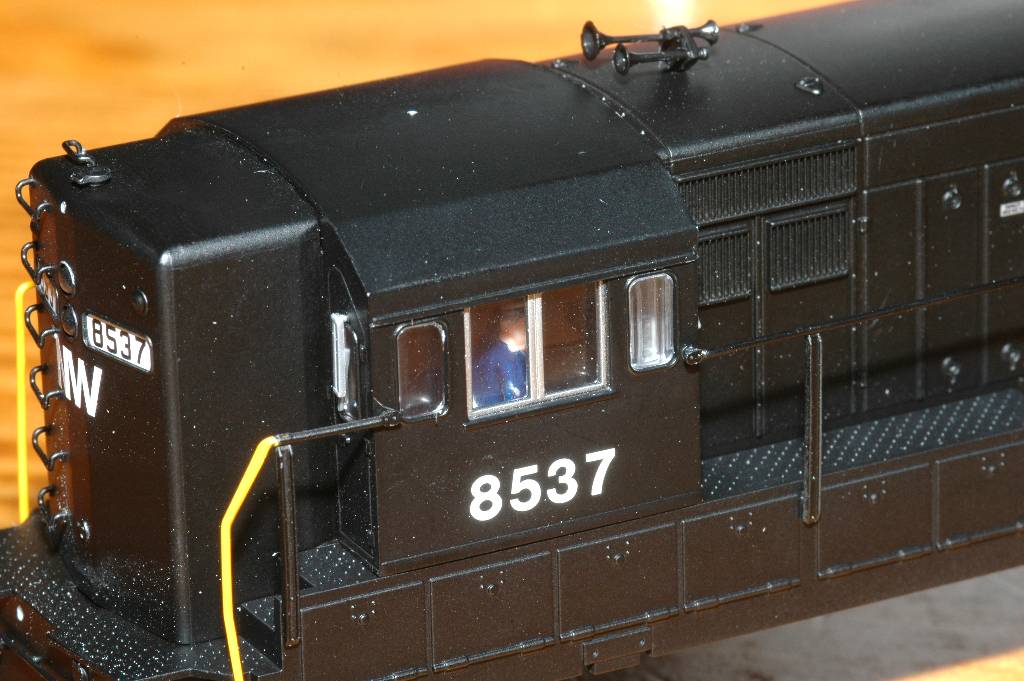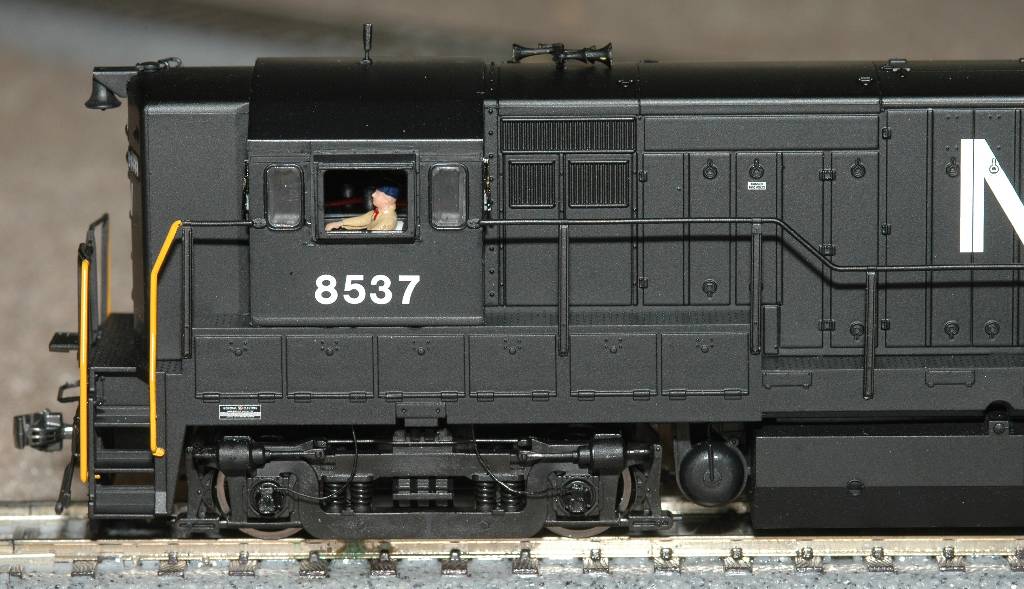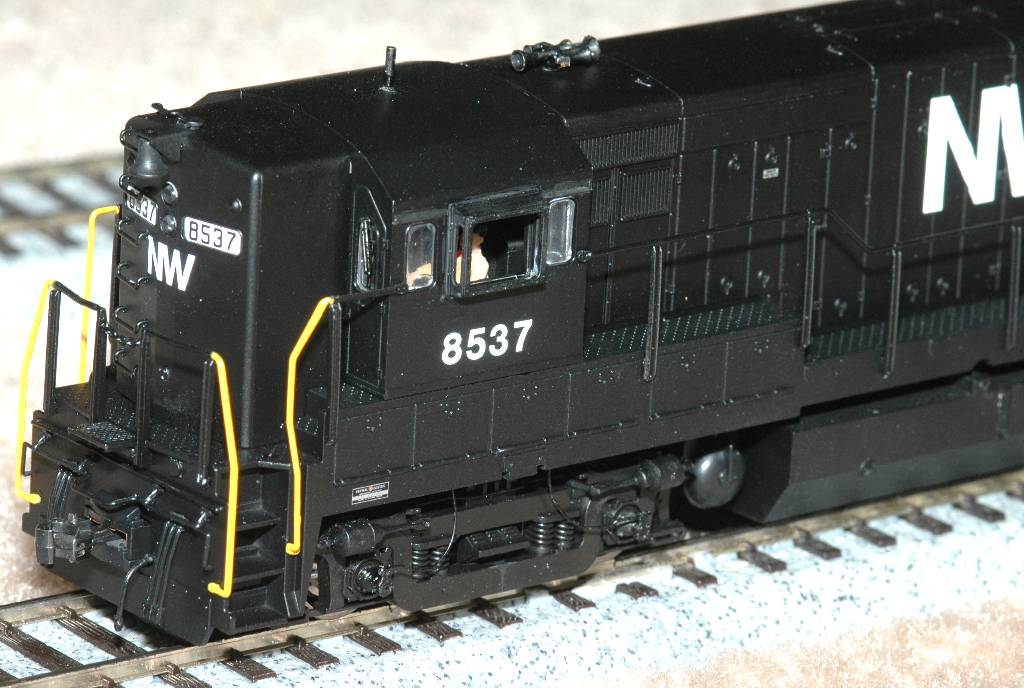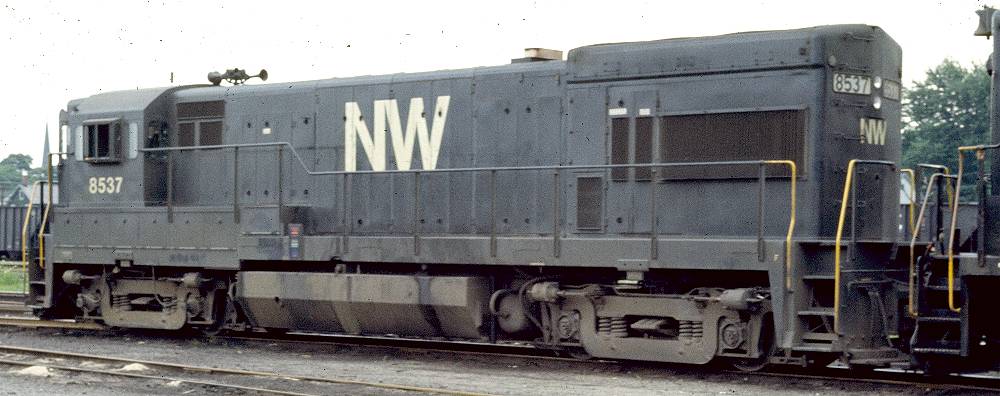Of all the predictions I could have made for the hobby 10 years ago, I never would have dreamed that today I'd be holding in my hand a factory painted, ready to run high nose U30B in N&W 13-dip black.
With a total of 110 units, N&W had more U30Bs than anybody else. All were high nose, and they were in two major groups. The first group was numbered 1930-1965 built in 1967. The second major group was numbered 8465-8539 and delivered in 1970-71. I say major groups because each has sub-phase details within, but they have very different body styles from each other. The 1967 built units resemble the earlier U28B substantially, although they are not identical - the radiator section has visible differences. Proto 2000 has produced an excellent version of this shell, albeit in low nose form only and with a weird drive. But the subject of this review is the new Atlas model which represents the later class, specifically the final order #8525-8539 delivered in September through November of 1971 and came from the factory in N&W's then-new 13-dip scheme.
The Atlas U30B is an evolution of their older U23B model, but it has a number of major improvements. The trucks are the new, upgraded AAR-B trucks first seen on the Alco C420 last year, and make a big difference with separate brake cylinders. The drive is also upgraded to current Atlas configuration, with smaller flywheels and the vertical 2-speaker housing for sound systems. My sample is the Silver Series DCC-ready version, so the speaker housings contain a couple of flat cast metal weights, which add to the model's heft and can be easily swapped out for a DIY sound installation. The operating performance is exactly what you've come to expect from Atlas - very consistent performance, smooth running and starting, and most importantly - it runs just like your other Atlas diesels instead of some pie-in-the-sky gear ratio of the month or electronic speed governor or B-bus undervolt eliminator. Houston, there's no problem under the hood and while we sometimes take that for granted, Atlas should be commended for sticking with the proven winner. The lighting is provided by LEDs, and the circuit board is equipped with an NMRA type 8-pin socket. I should also mention that the location of pin 1 is *clearly* indicated by a triangle that is embedded in the board. When a plug can be inserted more than one way, an indicator is essential and all too often missing from these plug & play boards. FYI, the orange wire on your NMRA plug goes into the pin with the triangle.
My preference for Atlas locos is to use an NCE decoder, but I was surprised to discover I had none of them left that I could plug in to the 8-pin socket. So I stuck a TCS T1P decoder in place for the time being. I am happy to report that after programming the decoder, it works perfectly as do both the front and rear LED lights - no smoke was released and no circuit boards were harmed in the process. It is still my intent to replace the decoder and circuit board with an NCE DASR and incandescent bulbs, but for the purpose of evaluating the factory setup, I wanted to keep it intact. It passes! Also, this might catch you a bit by surprise but - Atlas has wired up the N&W U30B with the long hood designated as front. This is correct for N&W practice, so if you install your decoder and going FWD means you are long hood leading, the trouble is not in your set - that's how it's supposed to be. However, I designate all of my locos as short hood front - that is my universal practice regardless of roadname, so that neither I nor a visitor needs to ask, look up, or trial and error any particular loco to see which end is front. Also - even though I primarily model N&W - I model the western, former NKP territory where short hood forward operation was the norm, and many of the lead units were ex-NKP and ex-WAB power that were SHF by design anyway. The U30Bs never seemed to popular with the N&W guys in Virginia and coal territory, and they seemed to have been mostly dispatched west. In the mid 1970s, there were lots and lots of U30Bs (plus the U28Bs) visible in and around Chicago.
My U30B came with the usual Accumate couplers, easily replaced with Kadee #58. Again, stuff we take for granted like Kadee drop-in capability is something being meddled with by other manufacturers... in particular the other one that starts with an A.... so I think it's worth a mention that Atlas is still doing the next best thing to including real Kadees: they aren't creating any obstacles to Kadees.
Now to the nitty gritty - the U30B shell itself. I had an opportunity to review the drawings and caught a couple of minor issues, most of which Atlas was already aware of. These corrections all made it to the final product, and the result is arguably the most accurate model of an N&W diesel to date. The U30B is neck and neck with the Proto high nose N&W GP30 in that department. The phase details, the high nose, even stepwell gussets and some of the minor hatch detail around the radiator is spot on. The radiators are not "see through" but on this phase of U-boat, they should not be. I generally prefer solid moldings for things that appear solid on the prototype at any normal viewing distance, and this is the case with the GE vertical corrugated radiator screens of the era.
When it comes to prototype-specific details, I never expect a manufacturer to provide every single bolt, cable, and pipe. It's just not practical. All I ask is that what is there be correct, or easily removed. There is room for underbody detailing of course - but what is there is correct. Ditto for the body, up to and including the unique N&W U-boat bell bracket. Up until now no one has made this part. Previous models, including a U30B I kitbashed from earlier Atlas U-boat components, I had to approximate this bell by modifying other parts. When I did three of the early U-boats (two U28Bs and a U30B) from the Proto shells, I just left the bells off hoping that a correct part would eventually come along. My patience has been rewarded, and I hope Atlas will have this part available in quantity from their parts department shortly. I need 4 of them right now just to apply or replace on finished models, and could use at least 6 more for planned future projects. When the first test shot photos were posted in the Atlas forum some time ago, there was some criticism of the bell shape - it looked too long, vertically. Atlas has corrected this, at least mostly - it's difficult to tell comparing to prototype photos. I am satisfied with it at present, but because the bell and bracket are separate pieces, one can easily replace just the bell portion with the bell of their choice. The bracket, the key unique element is dead on.
The high nose itself is another unique spotting feature. If you're not an N&W or Southern fan, you may not be aware that there are a total of four different high noses that were used on GE locomotives... 5 if you count the XP24 demonstrator. The high nose used on UP and Frisco U25Bs was unique to that model, having a sloped end and protruding number boards similar to the long hood end of the U25B. The N&W U28Bs and U30Bs, as well as the Southern U30Cs, U33Cs, and U23Bs used the classic U-boat high nose, as represented by the Hi-Tech details kit. Atlas has correctly captured the shape of this nose, which has some subtle contours as well as a beveled notch on the left side to permit the cab door to open. I haven't compared it directly to the Hi-Tech nose, but I think it will be virtually identical except for having open number boards. There are two other types of high noses for GE locomotives. First is the B30-7A type nose, which was used only on that model. It was used on all of the cabless BN B30-7A/7A1 locos and features an inverted number board casing, with the number boards in the upper half of the headlight area. For some reason, this same nose was also used on the Southern B30-7A1, which had full cabs and high noses, apparently because that was what they had around. This nose is/was available from Smokey Valley. Lastly, is the high nose used on the Southern B23-7s and B36-7s. It resembles the B30-7A nose but the number boards are in the lower half of the headlight area. Atlas has done this nose on their Southern and NS B23-7, and while it's correct in configuration the countours are a bit flat. Anyway, back on the topic, the U30B's high nose seems to be right on.
(continued)
With a total of 110 units, N&W had more U30Bs than anybody else. All were high nose, and they were in two major groups. The first group was numbered 1930-1965 built in 1967. The second major group was numbered 8465-8539 and delivered in 1970-71. I say major groups because each has sub-phase details within, but they have very different body styles from each other. The 1967 built units resemble the earlier U28B substantially, although they are not identical - the radiator section has visible differences. Proto 2000 has produced an excellent version of this shell, albeit in low nose form only and with a weird drive. But the subject of this review is the new Atlas model which represents the later class, specifically the final order #8525-8539 delivered in September through November of 1971 and came from the factory in N&W's then-new 13-dip scheme.
The Atlas U30B is an evolution of their older U23B model, but it has a number of major improvements. The trucks are the new, upgraded AAR-B trucks first seen on the Alco C420 last year, and make a big difference with separate brake cylinders. The drive is also upgraded to current Atlas configuration, with smaller flywheels and the vertical 2-speaker housing for sound systems. My sample is the Silver Series DCC-ready version, so the speaker housings contain a couple of flat cast metal weights, which add to the model's heft and can be easily swapped out for a DIY sound installation. The operating performance is exactly what you've come to expect from Atlas - very consistent performance, smooth running and starting, and most importantly - it runs just like your other Atlas diesels instead of some pie-in-the-sky gear ratio of the month or electronic speed governor or B-bus undervolt eliminator. Houston, there's no problem under the hood and while we sometimes take that for granted, Atlas should be commended for sticking with the proven winner. The lighting is provided by LEDs, and the circuit board is equipped with an NMRA type 8-pin socket. I should also mention that the location of pin 1 is *clearly* indicated by a triangle that is embedded in the board. When a plug can be inserted more than one way, an indicator is essential and all too often missing from these plug & play boards. FYI, the orange wire on your NMRA plug goes into the pin with the triangle.
My preference for Atlas locos is to use an NCE decoder, but I was surprised to discover I had none of them left that I could plug in to the 8-pin socket. So I stuck a TCS T1P decoder in place for the time being. I am happy to report that after programming the decoder, it works perfectly as do both the front and rear LED lights - no smoke was released and no circuit boards were harmed in the process. It is still my intent to replace the decoder and circuit board with an NCE DASR and incandescent bulbs, but for the purpose of evaluating the factory setup, I wanted to keep it intact. It passes! Also, this might catch you a bit by surprise but - Atlas has wired up the N&W U30B with the long hood designated as front. This is correct for N&W practice, so if you install your decoder and going FWD means you are long hood leading, the trouble is not in your set - that's how it's supposed to be. However, I designate all of my locos as short hood front - that is my universal practice regardless of roadname, so that neither I nor a visitor needs to ask, look up, or trial and error any particular loco to see which end is front. Also - even though I primarily model N&W - I model the western, former NKP territory where short hood forward operation was the norm, and many of the lead units were ex-NKP and ex-WAB power that were SHF by design anyway. The U30Bs never seemed to popular with the N&W guys in Virginia and coal territory, and they seemed to have been mostly dispatched west. In the mid 1970s, there were lots and lots of U30Bs (plus the U28Bs) visible in and around Chicago.
My U30B came with the usual Accumate couplers, easily replaced with Kadee #58. Again, stuff we take for granted like Kadee drop-in capability is something being meddled with by other manufacturers... in particular the other one that starts with an A.... so I think it's worth a mention that Atlas is still doing the next best thing to including real Kadees: they aren't creating any obstacles to Kadees.
Now to the nitty gritty - the U30B shell itself. I had an opportunity to review the drawings and caught a couple of minor issues, most of which Atlas was already aware of. These corrections all made it to the final product, and the result is arguably the most accurate model of an N&W diesel to date. The U30B is neck and neck with the Proto high nose N&W GP30 in that department. The phase details, the high nose, even stepwell gussets and some of the minor hatch detail around the radiator is spot on. The radiators are not "see through" but on this phase of U-boat, they should not be. I generally prefer solid moldings for things that appear solid on the prototype at any normal viewing distance, and this is the case with the GE vertical corrugated radiator screens of the era.
When it comes to prototype-specific details, I never expect a manufacturer to provide every single bolt, cable, and pipe. It's just not practical. All I ask is that what is there be correct, or easily removed. There is room for underbody detailing of course - but what is there is correct. Ditto for the body, up to and including the unique N&W U-boat bell bracket. Up until now no one has made this part. Previous models, including a U30B I kitbashed from earlier Atlas U-boat components, I had to approximate this bell by modifying other parts. When I did three of the early U-boats (two U28Bs and a U30B) from the Proto shells, I just left the bells off hoping that a correct part would eventually come along. My patience has been rewarded, and I hope Atlas will have this part available in quantity from their parts department shortly. I need 4 of them right now just to apply or replace on finished models, and could use at least 6 more for planned future projects. When the first test shot photos were posted in the Atlas forum some time ago, there was some criticism of the bell shape - it looked too long, vertically. Atlas has corrected this, at least mostly - it's difficult to tell comparing to prototype photos. I am satisfied with it at present, but because the bell and bracket are separate pieces, one can easily replace just the bell portion with the bell of their choice. The bracket, the key unique element is dead on.
The high nose itself is another unique spotting feature. If you're not an N&W or Southern fan, you may not be aware that there are a total of four different high noses that were used on GE locomotives... 5 if you count the XP24 demonstrator. The high nose used on UP and Frisco U25Bs was unique to that model, having a sloped end and protruding number boards similar to the long hood end of the U25B. The N&W U28Bs and U30Bs, as well as the Southern U30Cs, U33Cs, and U23Bs used the classic U-boat high nose, as represented by the Hi-Tech details kit. Atlas has correctly captured the shape of this nose, which has some subtle contours as well as a beveled notch on the left side to permit the cab door to open. I haven't compared it directly to the Hi-Tech nose, but I think it will be virtually identical except for having open number boards. There are two other types of high noses for GE locomotives. First is the B30-7A type nose, which was used only on that model. It was used on all of the cabless BN B30-7A/7A1 locos and features an inverted number board casing, with the number boards in the upper half of the headlight area. For some reason, this same nose was also used on the Southern B30-7A1, which had full cabs and high noses, apparently because that was what they had around. This nose is/was available from Smokey Valley. Lastly, is the high nose used on the Southern B23-7s and B36-7s. It resembles the B30-7A nose but the number boards are in the lower half of the headlight area. Atlas has done this nose on their Southern and NS B23-7, and while it's correct in configuration the countours are a bit flat. Anyway, back on the topic, the U30B's high nose seems to be right on.
(continued)

















